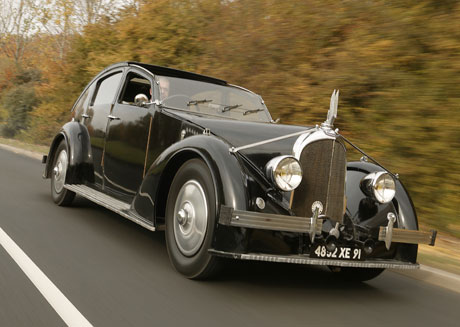Chassis Number: 50014
With a price of 88,000 francs when new, the purchase of an Aérodyne truly represented a small fortune, compared with the 70,000 francs asked for a Bugatti 57 Galibier or with the 22,000 francs necessary to buy one of the very new Citroën Traction 11 Légère sedans…
The car was revolutionary in form, with keel-shaped fenders and a hood integrated in the streamline shape very much then in fashion, but it was also technically revolutionary with its sliding roof powered by intake manifold pressure. With the top open, the windshield, simply attached, seems to float. The instrument panel included the adjustment of the shock absorbers, and an entirely electric gearbox actuated by levers under the steering wheel was optional. The interior arrangements of the Aérodyne testified to the functional concerns of Gabriel Voisin.
The folding rear seat, unseen before 1935, gave important space for luggage-not until the 1960s would this design be found on French production cars. Different, astonishing, even disturbing for certain observers of the time, the Aérodyne would know a fleeting career, being replaced in the fall of 1935 by a new, more conventional model, the “Clairière,” which had a vertical rear window, breaking the fastback line of its predecessor and offering only a sunroof opening over the front seats.
If it is known that only 28 C25 chassis were produced between 1934 and 1937, it is estimated that only seven with the Aérodyne body were built. The surviving specimens can today be counted on one hand. Encountering an Avions Voisin on the road in 1935 was therefore not a common thing, and rare are those who had the chance to observe an Aérodyne “in the open.” The car presented here, chassis number 50014, was bought second- or third-hand by the grandfather of the current owner on July 30, 1952, from Edouard Vaillant Cars in Levallois.
Between leaving the factory and 1952, it had belonged to the count Michel de Beauregard in Paris, where it was registered 8063 RQ7. Since 1952, it has remained in the same family-preserved in its exceptional state of originality, inside and out, and in perfect operating condition. We must pay homage to the family for not succumbing to the temptation of a restoration, which would have taken away its essence. Mechanically it has been well tended, its engine was rebuilt, and its operation is sweet, consistent, and quiet-essential qualities for Gabriel Voisin.

